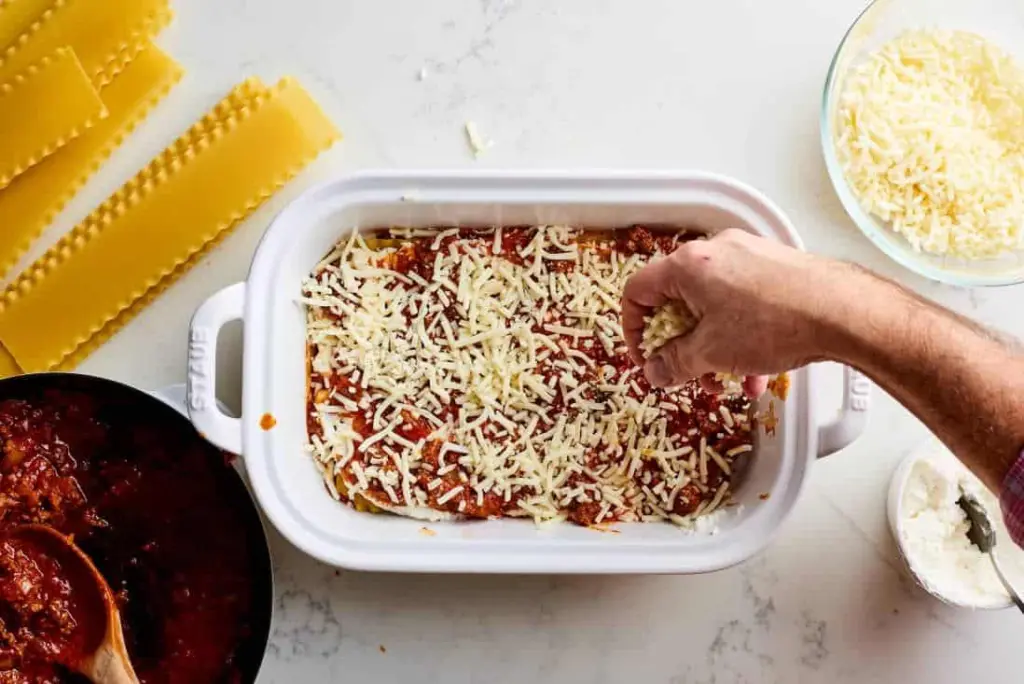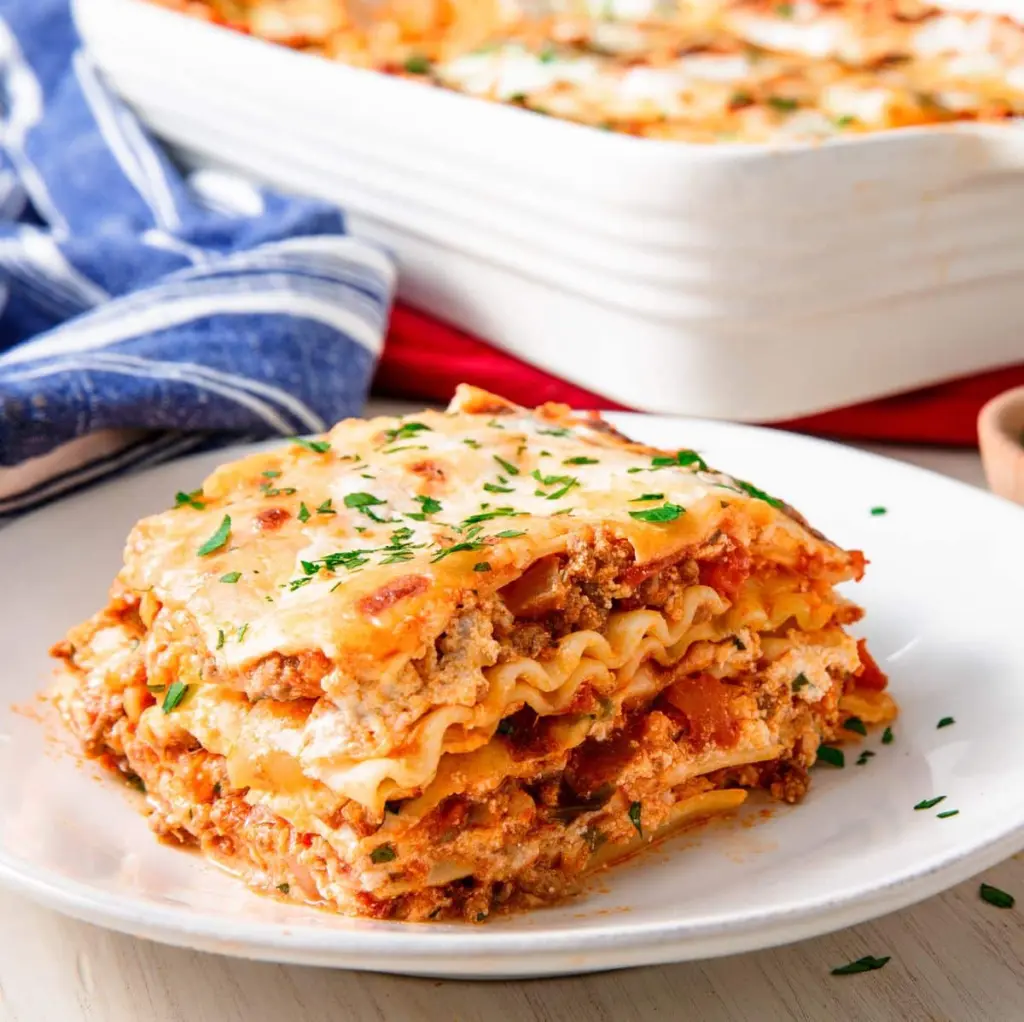
Lasagna, a quintessential Italian dish, boasts a rich history that traces back to the Middle Ages in Naples, Italy. Initially a special-occasion dish, lasagna has evolved from its humble beginnings to become a staple in global cuisine. This evolution highlights a deep-rooted connection to Italian culinary traditions, characterized by layered noodles, which are often ruffled, and a hearty filling that varies from region to region .Our comprehensive guide takes you through every step of making a lasagna recipe that not only rivals but surpasses your favorite restaurant’s version.
Table of contents
Why Lasagna is a Popular Dish
Lasagna’s global appeal stems from its versatility and the comfort it delivers. This dish has transcended its Italian origins to adapt to various cultural preferences worldwide, incorporating local ingredients and tastes. Its ability to be frozen and reheated without losing flavor enhances its popularity among those seeking convenient, yet hearty meals.
Ingredients and Preparation
Key Ingredients
High-Quality Meats for Flavor Depth
- Sweet Italian Sausage: Key for a robust, slightly spicy taste.
- Lean Ground Beef: Provides a rich, meaty base without excess grease.
Fresh and Flavorful Produce
- Onions and Garlic: These aromatics are sautéed to form a flavor foundation that’s unmistakably Italian.
The Best Tomato Products for a Perfect Sauce
- Crushed Tomatoes: Offers texture and freshness to the sauce.
- Tomato Paste and Sauce: Intensifies the richness, creating a velvety, deep tomato base.
Cheese Selection for Creamy Layers
- Ricotta Cheese: Adds a creamy, rich texture.
- Mozzarella Cheese: Ensures gooey, delightful cheese pulls.
- Parmesan Cheese: Brings a salty and nutty finish to each layer.
Pasta and Seasonings
- Lasagna Noodles: The backbone of the dish, cooked to just the right texture.
- Herbs and Spices: Fresh parsley, dried basil, Italian seasoning, fennel seeds, and black pepper combine to enhance the meaty layers with Italian flair.
Step-by-Step Guide to the Ultimate Lasagna
Preparing the Meat Sauce
- Cook sausage, ground beef, onion, and garlic in a Dutch oven until browned.
- Stir in tomato products and seasonings. Simmer to develop flavors deeply.
Assembly: The Art of Layering
- Spread a layer of meat sauce in a 9×13-inch baking dish.
- Arrange lasagna noodles, followed by ricotta cheese mixed with egg and parsley.
- Add mozzarella slices, more meat sauce, and a sprinkle of Parmesan.
- Repeat the layers, finishing with a top layer of cheeses.
Variations of Lasagna
- Vegetarian: Substitutes meat with spinach and mushrooms.
- Gluten-free: Uses gluten-free noodles.
- Vegan: Involves vegan cheeses and meat substitutes.

Cooking Techniques
Layering Techniques
Effective layering is crucial for lasagna’s texture and flavor. Start with a base layer of sauce to prevent sticking, followed by noodles, more sauce, followed by a cheese layer. Repeat the layering process until all ingredients are utilized.
Baking Tips
Bake lasagna at 375°F for about 25 to 45 minutes. Cover with foil to prevent excessive browning, then remove the foil in the last 10 minutes to allow the cheese to become golden and bubbly.
Serving and Presentation
Serving Suggestions
Let the lasagna rest for 15 minutes after baking to make cutting cleaner and easier.
Presentation Tips
Garnish with fresh basil or parsley to add color and freshness before serving.

Nutritional Information
Caloric Content
A typical serving of lasagna can range from 300 to 600 calories, primarily depending on the choice of ingredients like cheese and meat.
Dietary Adjustments
- Low-fat: Use low-fat cheese and lean meats.
- Keto: Substitute noodles with layers of zucchini or eggplant.
With this guide, you’re equipped to make a lasagna that not only satisfies the taste buds but also becomes a centerpiece at your dining table. The combination of rich flavors, expert techniques, and perfect layering ensures that your lasagna will be the highlight of any meal. Enjoy the process and the delicious results!
FAQs
What are the correct layers for lasagne?
Lasagne should be layered starting with a thin layer of sauce (tomato-based or ragù), followed by lasagna noodles, and then cheese. This pattern is usually repeated multiple times, often including a layer of white sauce (béchamel) in some recipes .
What is lasagna made of?
Lasagna typically consists of layers of flat pasta noodles, alternated with layers of sauce (either a tomato-based sauce or a meat sauce like ragù), and cheese, usually ricotta or mozzarella, with optional layers of béchamel sauce to add creaminess.
Should lasagna be 2 or 3 layers?
There is no strict rule on the number of layers for lasagna; it typically depends on the depth of the baking dish and personal preference. However, most recipes suggest between 3 to 4 layers for the best balance of flavors and textures .
What is the difference between lasagne and lasagna?
“Lasagne” is the plural form of “lasagna” used in Italian to refer to more than one sheet of pasta or the dish itself when referring to multiple servings. In English, “lasagna” often refers to both the singular and plural form of the dish.
What to make with lasagna?
Lasagna pairs well with simple sides such as a green salad, garlic bread, or steamed vegetables to balance the richness of the dish. For beverages, a light red wine like Chianti can complement the hearty flavors of lasagna.





